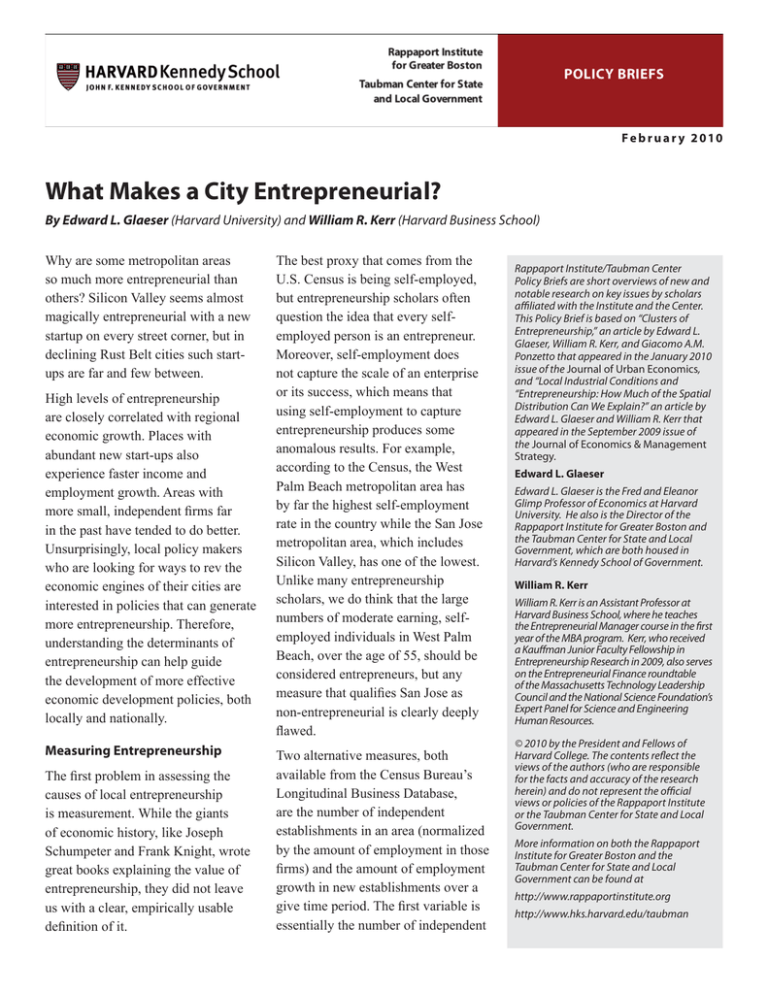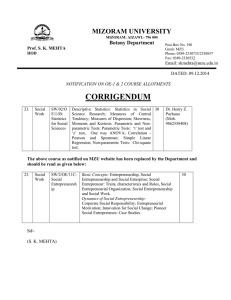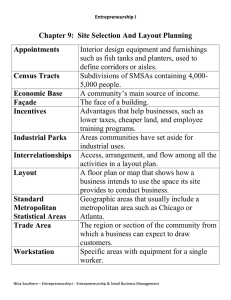What Makes a City Entrepreneurial? By Edward L. Glaeser
advertisement

F e b r u a r y 2 0 10 What Makes a City Entrepreneurial? By Edward L. Glaeser (Harvard University) and William R. Kerr (Harvard Business School) Why are some metropolitan areas so much more entrepreneurial than others? Silicon Valley seems almost magically entrepreneurial with a new startup on every street corner, but in declining Rust Belt cities such startups are far and few between. High levels of entrepreneurship are closely correlated with regional economic growth. Places with abundant new start-ups also experience faster income and employment growth. Areas with more small, independent firms far in the past have tended to do better. Unsurprisingly, local policy makers who are looking for ways to rev the economic engines of their cities are interested in policies that can generate more entrepreneurship. Therefore, understanding the determinants of entrepreneurship can help guide the development of more effective economic development policies, both locally and nationally. Measuring Entrepreneurship The first problem in assessing the causes of local entrepreneurship is measurement. While the giants of economic history, like Joseph Schumpeter and Frank Knight, wrote great books explaining the value of entrepreneurship, they did not leave us with a clear, empirically usable definition of it. The best proxy that comes from the U.S. Census is being self-employed, but entrepreneurship scholars often question the idea that every selfemployed person is an entrepreneur. Moreover, self-employment does not capture the scale of an enterprise or its success, which means that using self-employment to capture entrepreneurship produces some anomalous results. For example, according to the Census, the West Palm Beach metropolitan area has by far the highest self-employment rate in the country while the San Jose metropolitan area, which includes Silicon Valley, has one of the lowest. Unlike many entrepreneurship scholars, we do think that the large numbers of moderate earning, selfemployed individuals in West Palm Beach, over the age of 55, should be considered entrepreneurs, but any measure that qualifies San Jose as non-entrepreneurial is clearly deeply flawed. Two alternative measures, both available from the Census Bureau’s Longitudinal Business Database, are the number of independent establishments in an area (normalized by the amount of employment in those firms) and the amount of employment growth in new establishments over a give time period. The first variable is essentially the number of independent Rappaport Institute/Taubman Center Policy Briefs are short overviews of new and notable research on key issues by scholars affiliated with the Institute and the Center. This Policy Brief is based on “Clusters of Entrepreneurship,” an article by Edward L. Glaeser, William R. Kerr, and Giacomo A.M. Ponzetto that appeared in the January 2010 issue of the Journal of Urban Economics, and “Local Industrial Conditions and “Entrepreneurship: How Much of the Spatial Distribution Can We Explain?” an article by Edward L. Glaeser and William R. Kerr that appeared in the September 2009 issue of the Journal of Economics & Management Strategy. Edward L. Glaeser Edward L. Glaeser is the Fred and Eleanor Glimp Professor of Economics at Harvard University. He also is the Director of the Rappaport Institute for Greater Boston and the Taubman Center for State and Local Government, which are both housed in Harvard’s Kennedy School of Government. William R. Kerr William R. Kerr is an Assistant Professor at Harvard Business School, where he teaches the Entrepreneurial Manager course in the first year of the MBA program. Kerr, who received a Kauffman Junior Faculty Fellowship in Entrepreneurship Research in 2009, also serves on the Entrepreneurial Finance roundtable of the Massachusetts Technology Leadership Council and the National Science Foundation’s Expert Panel for Science and Engineering Human Resources. © 2010 by the President and Fellows of Harvard College. The contents reflect the views of the authors (who are responsible for the facts and accuracy of the research herein) and do not represent the official views or policies of the Rappaport Institute or the Taubman Center for State and Local Government. More information on both the Rappaport Institute for Greater Boston and the Taubman Center for State and Local Government can be found at http://www.rappaportinstitute.org http://www.hks.harvard.edu/taubman What Makes a City Entrepreneurial? establishments per worker, which is akin to firm size. The major flaw with this measure is that it is static. The second measure captures the level of growth due to new activity in a region. Luckily, the two measures are highly correlated which raises the hopes that they are both capturing something akin to what we think of as entrepreneurship. Using either of these variables, we find that all else being equal, regional economic growth is highly correlated with an abundance of smaller firms. Specifically, a 10 percent increase in the number of firms per worker in a metropolitan region in 1977 is associated with a nine percent increase in employment growth in that region between 1977 and 2000. (See Figure 1) In fact, along with January temperature and share of the population with college degrees, an abundance of small, independent firms is one of the best predictors of urban growth, a fact that raises questions about the occasional local development strategy of chasing large employers with generous tax breaks. R appapor t Institute | Taubman Center POLIC Y BRIEFS The Connection between Entrepreneurship and Growth Figure 1 illustrates connection between firm size and growth, but is this relationship the result of some omitted variable — or set of variables — that increases both the number of firms and city growth? For example, one could easily imagine that small independent firms are as much a reflection of good local policies as an independent cause of growth. Together with Giacomo Ponzetto of Barcelona’s Pompeu Fabra, we have explored the connection between small independent firms and subsequent growth using both a wide range of controls and focusing on within city, within industry variation. Our measure of employment growth was the number of jobs associated with new manufacturing establishments, both those that are independent and those that are associated with older firms. Our measure of initial entrepreneurship was the number of independent establishments per worker. Figure 1: Employment Growth and Firms Per Worker 2 What Makes a City Entrepreneurial? We focused on city-industries, which are industrial sectors within given metropolitan areas, like fur manufacturing in New York or computers in Silicon Valley. We could then control for all city-level and industry-level trends. Essentially, we were asking whether a city-industry cluster that has an unusual number of small, independent firms (relative to both the metropolitan-area norm and the industry-norm) grows faster than the average R appapor t Institute | Taubman Center POLIC Y BRIEFS a local culture of entrepreneurship. Holding the number of independent establishments in a cityindustry constant, we found that employment growth was higher when the number of independent establishment in the city outside the industry was also higher. Unsurprisingly, additional independent establishments within industry had a stronger impact than establishments in other industries. Causes and Effects A ten percent increase in the number of firms per worker in a metropolitan region in 1977 is associated with a nine percent increase in employment growth in that region between 1977 and 2000. firm in the metropolitan area and faster than similar firms in the nation as a whole. We found that 10 percent increase in average establishment size in 1992 is associated with a 7 percent decline in subsequent employment growth due to new startups. Employment growth due to new establishments that are associated with older firms also fell by almost 5 percent. These reductions came primarily through weaker employment growth in small firm entrants. Since we were looking within-industries and within-metropolitan area, simple theories emphasizing just industry-wide or city-wide forces, like low taxes or amenities, could not explain the results. It isn’t that such factors do not matter, it’s that they are unlikely to explain within-city patterns. In addition, we controlled for other factors, like the average age of establishments in the city-industry. In this way, we could be more confident that our results did not merely reflect industry life-cycle effects. We also found that there were entrepreneurship spillovers across industries, perhaps reflecting But if the relationship between an abundance of smaller firms and urban success is real, then why are some regions more entrepreneurial than others? One possibility is that there might be particularly high returns for entrepreneurs in particular places and in particular industries. For example, Silicon Valley’s high rate of entrepreneurship over the past 30 years could have due to abnormally high returns in California’s computer sector, perhaps due to Defense Department support, as the industry took off. But our proxy for the returns to entrepreneurship, the value of shipments per worker, is not higher in places that have more independent establishments. To us, this suggests that the returns to production are probably comparable, rather than higher, in city-industry clusters with lots of small establishments. In her classic study of Silicon Valley, AnnaLee Saxenian noted its abundance of smaller, independent firms relative to Boston’s Route 128 corridor. These firms, she argued, caused further entrepreneurship because they lowered the effective cost of entry through the development of independent suppliers, venture capitalists, and an entrepreneurial culture. Similarly, in 1961, Benjamin Chinitz argued that presence of small, independent suppliers was particularly crucial for understanding why New York was so much more entrepreneurial than Pittsburgh, where the economy was dominated by large, vertically integrated steel companies. 3 What Makes a City Entrepreneurial? There is data suggesting that costs for entrepreneurs do matter. For example, there is a strong positive correlation between labor intensity – the ratio between payroll and sales – and subsequent startup growth, which again supports the view that fixed costs are important. Even more importantly, as Chinitz suggested, holding city-industry establishment size constant, subsequent employment growth is further aided by the presence of small establishments in other industries in a metropolitan area. In an analysis of just manufacturing start-ups, we recently found that an abundance of independent suppliers was one of the best predictors of new establishment formation. A third explanation is that for a variety of reasons, some areas may have a greater supply of entrepreneurs. These factors might include differences in the age and education of regions’ residents or innate regional cost advantages, such as coastal access for export industries, cheap electricity for aluminum production, and a favorable climate. In general, places with more educated workforces have more startup growth, especially in industries that depend upon college-educated workers. Such industries, moreover, are more likely to locate in higher-amenity regions, particularly those with favorable climates. However, once again this sorting does not explain the establishment size effect. Entrepreneurship and Public Policy Recognizing the powerful correlations between entrepreneurship and regional economic growth, state and local policymakers may well want to do more to encourage entrepreneurship in their communities. They should, however, proceed cautiously because economic research is only just beginning to fully understand key issues, like the causes of spatial variations in entrepreneurial activity. R appapor t Institute | Taubman Center POLIC Y BRIEFS However, the available evidence does suggest a few tentative policy conclusions. First, investing too much in attracting large, mature firms may not be good policy. These firms may provide an immediate headline associated with new jobs, but growth is more reliably correlated with small, independent firms. Second, there is little reason to have much faith in the ability of local governments to play venture capitalist. Classic economic research found that Japan’s Ministry of International Trade and Investment, which was staffed with Japan’s best minds, generally picked losers. Why should local investment funds be able to do any better? Moreover, the evidence linking growth in local finance and entrepreneurship suggests that the best role for government is simply to encourage competition among local banks and financiers. Finally, while venture capitalists are highly concentrated in three large areas—San Francisco, New York, and Boston—they seem quite capable of investing outside of those places. Third, there is much to be said for the strategy of focusing on the quality of life policies that can attract smart, entrepreneurial people. The best economic development strategy may be to attract smart people and get out of their way. This approach is particularly appealing because the downside is so low. What community ever screwed up by providing too much quality of life? Finally, there is a robust link between educational institutions and certain types of high return entrepreneurship. The history of Silicon Valley would be totally different without Stanford. Good universities have faculty members who are involved in local start-ups and train students who may become entrepreneurs and the employees of entrepreneurs. These facts do not imply that universities should be locally subsidized, but they do suggest that imposing costs that restrict the growth of such institutions can be costly. 4







